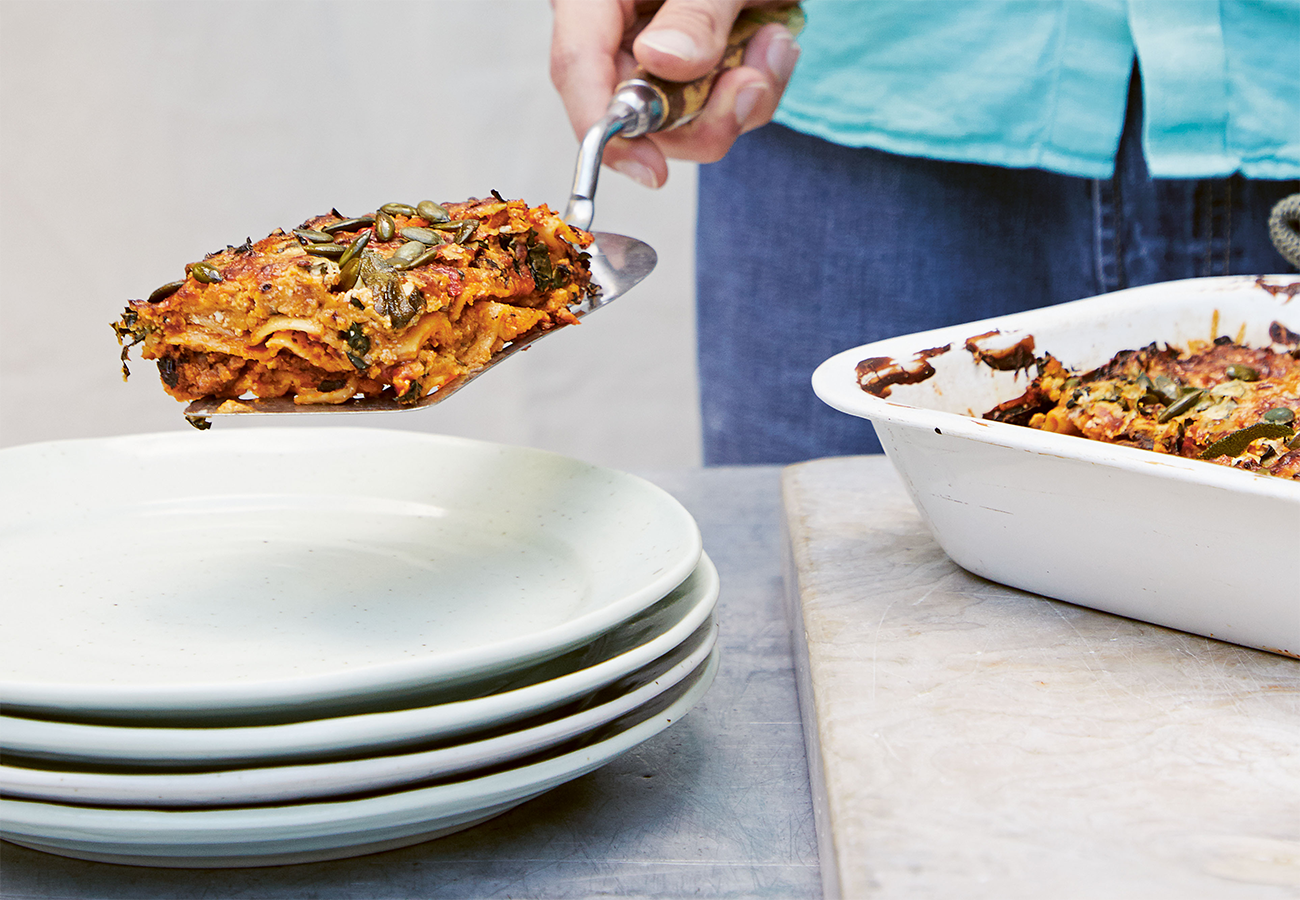 Credit: Brain Brilliance by Lucinda Miller (Quadrille, £24), Photography © Ali Allen
Credit: Brain Brilliance by Lucinda Miller (Quadrille, £24), Photography © Ali Allen
Lucinda says: “A delicious and comforting lasagne with a brainy twist! Aromatic sage is helpful for mood and memory, the chicken liver contains plenty of iron and vitamin B12, while zinc-rich pumpkin seeds are a great topping. Make this with traditional lasagne sheets, or there’s the option to use courgette ribbons to help reduce a blood glucose spike.
“Lasagne is ideal to feed a crowd, but you can assemble this as individual servings and store these, uncooked, in the freezer.”
Serves 4–6
Ingredients
Meat layer
- 2 tbsp olive oil
- 1 onion, finely diced
- 1 garlic clove, crushed
- 400g (14oz) sausage meat or minced (ground) pork
- 2 chicken livers, trimmed and roughly chopped
- 1 red (bell) pepper, deseeded and finely diced
- 2 tsp fennel seeds
- 2 tsp fresh thyme leaves or 1 tsp dried
- 2 tsp smoked paprika
- 4 tbsp tomato purée (paste)
- 125ml (½ cup) chicken stock or bone broth
Butternut squash layer
- 1 butternut squash, seeds removed, peeled and cut into chunks
- 2 tbsp olive oil
- 2 tsp ground nutmeg
- small handful of sage leaves, roughly chopped
- 1 tbsp butter
- 150g (scant ¾ cup) ricotta or goat’s cheese
- salt and black pepper
Creamy layer
- 100g (½ cup minus 1 Tbsp) ricotta or goat’s cheese or almond cheese
- ½ tsp ground nutmeg
- handful of cavolo nero or kale, roughly chopped
- 6 oven-ready lasagne sheets, or 2 courgettes (zucchini) finely sliced or spiralized into ribbons
- 2 tbsp grated Parmesan or pecorino
- 2 tbsp pumpkin seeds
- 1 tbsp chopped sage leaves, plus 5–6 whole leaves
Method
- First make the meat layer. Heat the olive oil in a large frying pan (skillet) or saucepan and sauté the onion for 3–5 minutes until soft and translucent. Add the garlic, sauté for a further minute, then add the sausage meat and livers and cook, stirring, until well browned.
- Add the red pepper, fennel, thyme, paprika, tomato purée and finally the stock or broth. Bubble gently for at least 45 minutes, stirring from time to time. You want a nice thick meaty sauce.
- Meanwhile, prepare the butternut squash layer. Lightly coat the squash in the oil, then sprinkle with the nutmeg and some salt and pepper. Roast in a preheated oven at 200°C/180°C fan/400°F/Gas mark 6 for 45 minutes. Add the sage for the last 5 minutes.
- Blend the butternut squash with the butter and ricotta. Set aside.
- The creamy layer is easy: simply blend the ricotta and nutmeg together and stir in the cavolo nero. Set aside.
- Take an ovenproof dish measuring about 29 x 22cm (11.5 x 8.5in) and assemble as follows. Spoon a third of the meat sauce over the base of the dish. Cover with 3 lasagne sheets or half the courgette ribbons in a single layer. Cover with half the butternut squash mixture, spreading it evenly. Repeat those layers using half the remaining meat sauce, all the remaining lasagne sheets or courgette and all the butternut squash. Make a further layer using the rest of the meat sauce, then top with the creamy ricotta to make a final layer. Sprinkle with the Parmesan, pumpkin seeds and chopped sage.
- Cook the lasagne in the preheated oven for 30 minutes. Rub a little extra oil over the 5 or 6 sage leaves. Remove the lasagne from the oven, top with the sage leaves, and return the dish to the oven for another 15–20 minutes until the cheese is golden and bubbling.
- Store in the refrigerator for up to 3 days or in the freezer for up to 3 months. To reheat from chilled, cover the dish with foil and put in a preheated oven at 180°C/160°F fan/350°F/Gas mark 4 for 20–30 minutes until piping hot.
Dairy-free – use soft almond or cashew cheese and vegan spread / gluten-free – use gluten-free lasagne sheets / nut-free / sesame-free / egg-free / soy-free
About the book:
Brain Brilliance 60 Nourishing Recipes and a Nutritional Toolkit for Dyslexia, Dyspraxia, ADHD, Autism and all Neurodivergent Kids by Lucinda Miller
Brain Brilliance offers 60 delicious and nutritious recipes as well as a wealth of diet and supplement tips and hacks for children living with unique and special brains. If you are a parent, teacher or carer, you can learn how to help them thrive and live their best neurodivergent life…with a little bit of nutritional know-how. The best news is that no one needs to wait for a diagnosis to benefit from better diet and nutrition. You can begin nourishing your child’s brain cells right away, setting the foundations for a healthier and happier future.
Drawing from over 25 years’ experience as a family naturopath and functional medicine practitioner, Lucinda Miller highlights how to rebalance your child’s blood glucose levels to prevent ‘hanger’ and meltdowns, and teaches you to understand how inflammation and the immune system can also dysregulate the neurodivergent brain, and what to do about it.
Discover more healthy and delicious recipes here.




